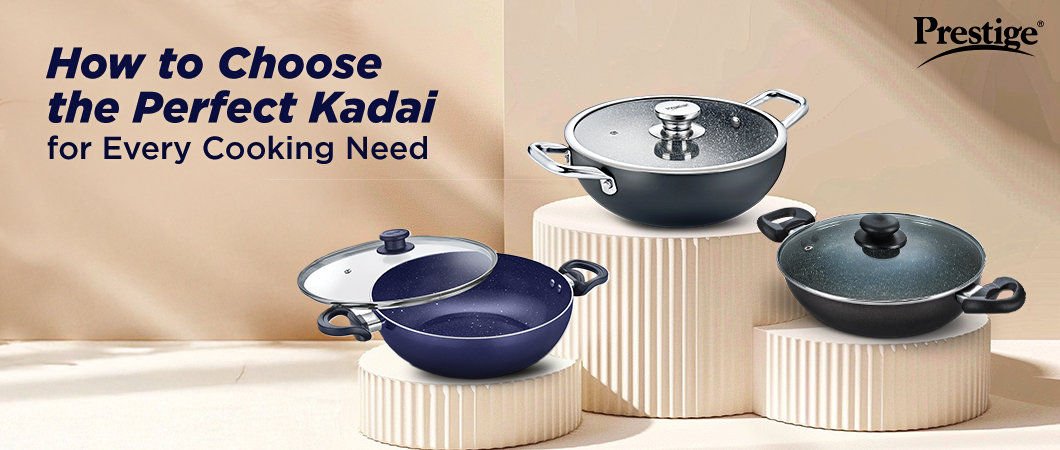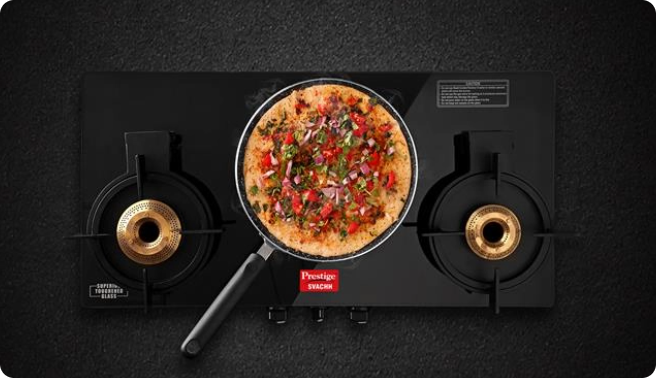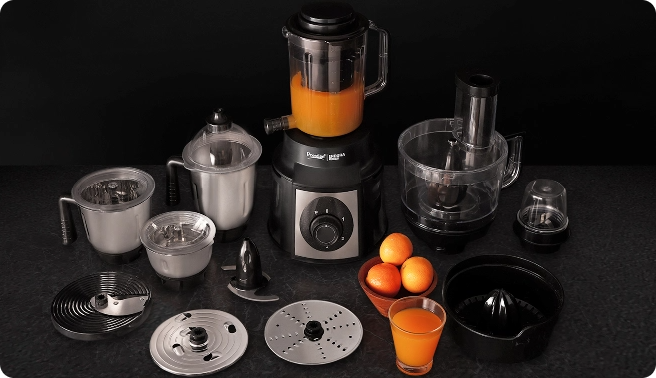Introduction to Kadai
The kadai (or kadhai) is an essential piece of cookware in Indian kitchens. Its origins date back centuries, with its distinctive wide, deep sides and flat bottom making it ideal for a wide range of cooking tasks. From deep-frying to stir-frying, sautéing to simmering, the kadai serves a versatile purpose. The adaptability of the kadai across different cuisines and cooking techniques is what makes it a must-have for any cook, whether you're a beginner or an experienced chef. Available in a variety of materials and designs, choosing the right kadai can elevate your cooking, making each dish more flavourful and ensuring that your culinary efforts meet the highest standards. This blog will guide you through understanding the different types of kadais, tips for choosing the right one, and how to use it for different cooking styles and recipes.
Different Types of Kadai and Their Features
The market today offers a variety of kadais, each designed to suit specific cooking needs and preferences. Below are some of the most popular types of kadais and their key features:
1. Non-Stick Kadai
Non-stick kadais are incredibly popular due to their ability to cook with minimal oil and their ease of cleaning. The non-stick coating ensures that food doesn’t stick to the surface, making it ideal for cooking delicate dishes like eggs, fish, or vegetables. A Prestige non-stick kadai is an excellent choice, offering both durability and high-performance cooking. The non-stick kadai price typically starts at ₹800 and can go up to ₹3,000 depending on the size and brand.
Pros:
- Minimal oil usage
- Easy to clean
- Suitable for delicate cooking
Cons:
-
Not suitable for high-heat cooking
-
Requires gentle handling to prevent damage
2. Steel Kadai
A steel kadai is a reliable, long-lasting option for everyday cooking. It’s perfect for those who prefer to avoid non-stick coatings or who want a more long lasting and aesthetic option. It has a robust cooking surface. Steel kadais are ideal for high-heat cooking, making them suitable for stir-frying, shallow frying, and making curries. The steel kadai price generally ranges from ₹1000 to ₹2900 based on its size, design, and brand reputation.
Pros:
-
Durable and resistant to scratching
-
Compatible with high-heat cooking
-
Can be used with metal utensils
Cons:
-
Requires more oil to prevent food from sticking
-
Needs regular maintenance to keep it looking new
3. Cast Iron Kadai
Cast iron kadais are beloved for their excellent heat retention and even heat distribution. These kadais are perfect for slow cooking, braising, and simmering stews or curries. Cast iron’s ability to maintain heat over time means less energy is needed to cook your food, making it a more energy-efficient choice. A cast iron kadai typically requires seasoning to maintain its non-stick qualities and to prevent rust.
Pros:
- Excellent heat retention
- Suitable for a wide variety of cooking techniques
- Extremely durable
Cons:
-
Heavy and difficult to handle
-
Requires regular seasoning and care
4. Triply Kadai
A triply kadai is made of three layers: stainless steel on the outside, aluminium in the middle for better heat conduction, and another layer of stainless steel on the inside. This type of kadai provides uniform heating, which ensures your food is cooked evenly and retains the flavors. It is also induction-compatible, making it a versatile option for modern kitchens.
Pros:
- Even heat distribution
- Induction-compatible
- Very durable and long lasting
Cons:
-
Higher price point
-
Not non-stick, so requires proper oiling to avoid sticking
5. Aluminium Kadai
Aluminum kadais are lightweight and heat up quickly, making them a popular choice for fast cooking methods like stir-frying. However, they are not as durable as other materials and can lose their shape over time with frequent use. Aluminum kadais are often coated with a non-stick surface, which enhances their performance but may degrade over time with high heat.
Pros:
- Lightweight and easy to handle
- Fast heating
Cons:
-
Less durable compared to other materials
-
Can be scratched easily, especially when using metal utensils.
6. Ceramic Kadai
Ceramic kadais are gaining popularity for their non-toxic and eco-friendly nature. The ceramic coating ensures that food doesn’t stick, while also being free from harmful chemicals like PTFE and PFOA. These kadais are perfect for slow cooking and maintaining the natural flavors of dishes. A ceramic kadai, such as one from brands like Prestige, offers excellent heat retention and an elegant appearance. The price of a ceramic kadai ranges from ₹1,000 to ₹4,000, depending on the size and quality.
Pros:
-
Non-toxic and eco-friendly
-
Excellent heat retention
-
Aesthetic design
Cons:
-
Not suitable for high-heat cooking
-
Requires gentle handling to avoid chipping
6 Tips to Consider When Choosing a Kadai for Your Cooking Needs
Selecting the right kadai requires thoughtful consideration of several factors. Here are six key tips to help you choose the perfect one for your kitchen:
-
Material Compatibility:
The material of the kadai determines how it performs with different cooking styles. If you often cook stir-fried dishes or shallow fry, a steel kadai is an excellent choice. If you prefer low-fat cooking or want easy cleanup, opt for a non-stick kadai. For slow cooking or making stews, a cast iron kadai would be ideal. -
Size and Capacity:
Consider the size of the kadai based on the number of servings you typically prepare. A 2-liter kadai is suitable for small family meals, while a 5-liter version is better for larger portions. It’s essential to choose a size that aligns with your usual cooking needs. -
Handle Design and Comfort:
The handle is a crucial feature of any kadai. Look for ergonomically designed handles that are heat-resistant and provide a comfortable grip. Prestige kadais come with handles that offer great control, making them safe and easy to maneuver. Some kadais also have helper handles, which are useful for lifting heavier pots. -
Ease of Maintenance:
Different materials require different levels of maintenance. For instance, cast iron kadais need to be seasoned and regularly maintained to avoid rusting. Non-stick kadais require gentle cleaning with a soft sponge to preserve the coating. If you prefer low-maintenance cookware, a steel kadai or triply kadai may be a better choice. -
Budget:
Set a budget and look for a kadai that meets both your functional needs and your price range. While high-end kadais like Prestige non-stick kadais may cost more, they offer long-term durability and performance. Non-stick kadai prices range from ₹800 to ₹3,000, while steel kadai prices typically fall between ₹600 and ₹2,500. -
Health Considerations:
If you're health-conscious, choose a non-stick kadai that is free of harmful chemicals like PFOA. Many modern Prestige kadais feature non-stick coatings that are not only effective but also PFOA-free, offering healthier cooking options.
How to Use a Kadai for Different Dishes
The kadai is versatile and can be used to prepare a variety of dishes. Here’s how to make the most of your kadai:
-
Frying:
Whether it’s deep-frying pakoras or shallow-frying fish, a deep kadai works best. The deep sides ensure oil doesn’t splatter, and the large surface area allows for even cooking. -
Stir-Frying:
For quick stir-fries, choose a steel kadai or non-stick kadai. The quick heating properties of these materials make them ideal for fast cooking at high heat. -
Making Curries and Stews:
A cast iron kadai or a triply kadai is perfect for slow-cooked curries or stews. These kadais retain heat and ensure the flavors develop evenly over time. -
Roasting Spices:
Steel kadais or cast iron kadais are best for dry roasting spices due to their heat retention properties. The even heat ensures that the spices don’t burn and are roasted uniformly.
Why Choose Prestige Kadai?
TTK Prestige is a name synonymous with quality and innovation in cookware. Their kadais are designed for superior cooking performance and durability. Whether you opt for the Prestige non-stick kadai or a Prestige steel kadai, you can be assured of high-quality materials that offer longevity and excellent heat retention. Prestige kadais come with ergonomic handles, durable coatings, and easy maintenance, making them a perfect addition to any kitchen.
Budget Considerations for a Kadai
When purchasing a kadai, it’s important to strike a balance between quality and price. High-end options like Prestige kadais may cost a bit more, but their superior materials and long-lasting durability make them a worthwhile investment. You can find cost efficient Kadhais on some of India’s top websites online or you can skip the hassle and visit shop.ttkprestige.com.
Conclusion
Choosing the right kadai for your cooking needs is essential to ensure both effective cooking and ease of use. Whether you prefer a non-stick kadai for healthy cooking or a steel kadai for its durability, there is a perfect choice for everyone. Always consider factors like material, size, and maintenance when making your decision.
Frequently Asked Questions (FAQs)
1) What is the best kadai for stir-frying?
A) A Ceramic or a triply kadai is ideal for stir-frying. Both types offer even heat distribution and prevent food from sticking, making them perfect for quick, high-heat cooking methods.
2) Are non-stick kadais safe for health?
A) Yes, provided you select a PFOA-free non-stick kadai. These are considered safe for cooking, as they avoid harmful chemicals often associated with older non-stick coatings. Always choose reputable brands for peace of mind.
3) How do I season a cast iron kadai?
A) To season a cast iron kadai, clean it thoroughly, then apply a thin layer of oil (such as vegetable or flaxseed oil) and heat it until the oil darkens and bonds to the surface. This process creates a natural non-stick coating and prevents rust.
4) Can I use a kadai on an induction cooktop?
A) Triply kadais and some steel kadais are designed to be induction-compatible due to their magnetic properties. Cast iron kadais may also work if their base is flat and suitable for induction cooking. Additionally, non-stick kadais with an induction base can also be used. Users should check the product manual or packaging to confirm compatibility..
5) What is the average price of a Prestige kadai?
A) Prestige kadais vary in price depending on the material and size. A non-stick Prestige kadai typically ranges from ₹800 to ₹3,000, while steel kadais or cast iron kadais may cost ₹1,500 to ₹4,500.
6) How do I clean a non-stick kadai?
A) Cleaning a non-stick kadai is simple: wash it with mild dish soap and a soft sponge. Avoid abrasive pads that could damage the coating. For tougher residue, soak the kadai in warm, soapy water before cleaning.
7) What size kadai should I choose?
A) Choose a kadai based on the number of servings you typically prepare. A 2-liter kadai is suitable for small meals, while larger sizes (5-7 liters) are ideal for families or batch cooking.
















